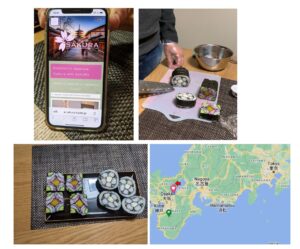Traveling isn’t just about seeing; it’s also about doing. That’s why I like to take cooking classes when I’m on the road. It’s a great way to roll up your sleeves and taste the culture of the country you’re visiting. This is particularly true in Japan, where the culture can seem so dense and impenetrable. You often feel like you’re observing things from a distance, through a lens, without fully understanding what’s going on!
Donica and I arrive at our Sakura sushi-making experience at ~6pm. Located in a modern, workshop hall in a quiet corner of Kyoto, the center offers all kinds of cultural classes, from tea ceremony to flower arranging to calligraphy. But we’ve come for the Kazarimaki “Art” sushi class, taught by the wonderful Aya-Sensei. As we wash our hands and settle in, Aya explains how she is one of the only people in the country to practice the delicate craft of Art sushi. Oh sure,
anyone can make ordinary sushi rolls, but with Aya, you’re creating a delicious, edible work of art.
Although Donica has creative chops in abundance, I am definitely NO artist. As we start the class, I find myself feeling a wee bit nervous. It’s hard enough expressing one’s creativity without holding a really sharp knife in your hand! Luckily, making maki sushi isn’t rocket science, even for me. You simply lay out your sheet of nori seaweed on a small wooden palette, spread your rice thin, roll it up, remove the palette, and voila, a beautiful sushi roll. But hardly artistic! Aya’s genius is making multiple small rolls and stacking them up in a variety of wheel configurations. You then place the whole pile of rolls in a large nori sheet and roll the whole shebang together. It’s only when you cut your roll and view it from above that you receive the great reveal: a multi-colored, kaleidoscope pattern fit for a museum (and your tummy).
Working with a sushi master, of course, is kind of nerve wracking. I just know that Aya is looking at my sushi creation with a critical eye. “The leaves of the chrysanthemum pattern aren’t really symmetrical, are they? Those green cucumbers aren’t exactly balanced with the yellow takuan cucumbers!” If Aya is feeling aesthetic dissonance from my sushi, however, she doesn’t let on. Both Donica and I receive bounteous praise from our instructor, and then it’s time to eat!

From the picture of my final creation, what do you think? How did I do?
(Overcoming fear is usually more than just deciding to jump off a cliff. More often, it’s about overcoming your internal critic, the one that whispers, “You’re just going to embarrass yourself.” Travel is a great place to try new things with strangers who won’t necessarily be around to remind you of your failures. The question is, when you’re in a similar situation at home, with whom are you surrounding yourself? If your social circle is prone to point out your faults, perhaps it’s time to find a new social circle!)
